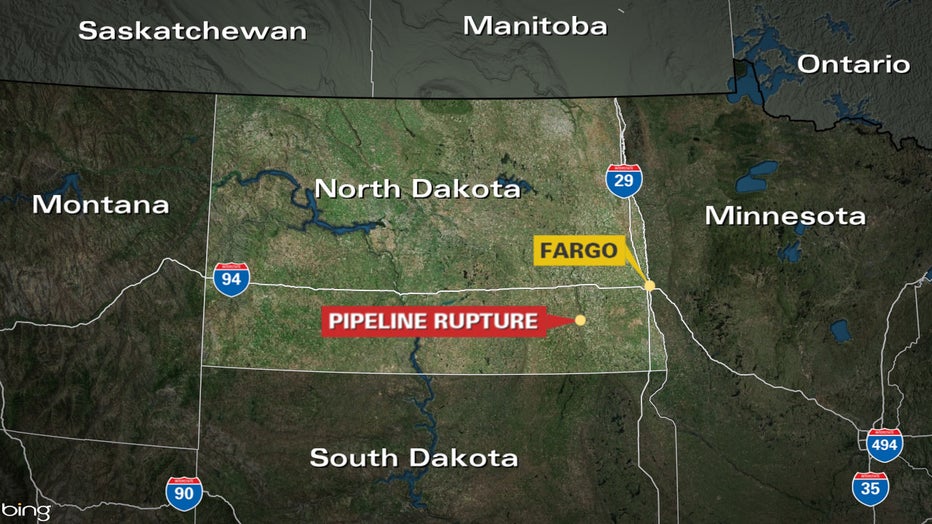Keystone oil pipeline ruptures in North Dakota; spill under investigation
Keystone oil pipeline ruptures in North Carolina
The Keystone oil pipeline was shut down Tuesday morning after it ruptured in North Dakota, with the spill confined to an agricultural field. The cause of the rupture and the volume of crude oil spilled were not immediately clear.
FORT RANSOM, N.D. - The Keystone oil pipeline ruptured Tuesday morning in North Dakota, with the spill confined to an agricultural field.
What we know:
KVRR reported that the eruption happened near Fort Ransom, North Dakota around 7:44 a.m. local time.
An employee working at the site near Fort Ransom heard a "mechanical bang" and shut down the pipeline within about two minutes, said Bill Suess, spill investigation program manager with the North Dakota Department of Environmental Quality.
Oil was reported surfacing 300 yards (274 meters) south of the pump station in a field, Suess said. Emergency personnel responded to the site, Suess said.
No people or structures were affected by the spill, he said. A nearby stream that only flows during part of the year was not impacted but was blocked off and isolated as a precaution, he said.

What we don't know:
The cause of the rupture and the volume of crude oil spilled were not immediately unclear.
It's unclear at what rate the 30-inch (0.8-meter) pipeline was flowing, but even at two minutes "it's going to have a fairly good volume," Suess said. "But ... we've had much, much bigger spills," including one involving the same pipeline a few years ago in Walsh County, North Dakota, he said.
"I don't think it's going to be that huge," Suess said.
What they're saying:
"At 7:44 this morning an employee on a pump station heard what was described as a mechanical bang," Suess said in a statement to FOX Television Stationsz. "He immediately shut down the pipeline and notified emergency personnel. The release is currently confined to an agricultural field south of the pump station."
"There is an ephemeral stream nearby that has been isolated," he continued. "The stream has not been impacted."
South Bow, a liquid pipeline business that manages the pipeline, said it shut down the pipeline after control center leak detection systems detected a pressure drop in the system. The spill is confined to an agricultural field.
"The affected segment has been isolated, and operations and containment resources have been mobilized to site," the company said. "Our primary focus right now is the safety of onsite personnel and mitigating risk to the environment."
What's next:
The size and cause of the spill are under investigation, according to the outlet.
What is the Keystone Pipeline?
The backstory:
The Keystone Pipeline was constructed in 2010 at a cost of $5.2 billion and carries crude oil across Saskatchewan and Manitoba through North Dakota, South Dakota, Nebraska, Kansas and Missouri to refineries in Illinois and Oklahoma.
Though the pipeline was constructed by TC Energy, it is now managed by South Bow as of 2024.
What is the Keystone XL pipeline?
An extension of the pipeline, Keystone XL, was proposed in 2008. According to FOX News, the pipeline has been at the forefront of political debate since the project began construction in 2010, and was eventually halted by former President Barack Obama before it was finished. Trump revived it during his first term.
However, former President Joe Biden ordered the pipeline cancelation via executive order on his first day in office in January 2021, leading to thousands of job losses.
TC Energy, the previous operator of the Keystone XL pipeline, ultimately gave up on the project in June 2021 as a result of Biden's decision to cancel its federal permits.
Then, in 2023, a federal judge tossed a legal challenge from nearly two dozen states asking the court to reinstate the pipeline's permits.
The pipeline had been scheduled to be completed in early 2023 and would transport an additional 830,000 barrels of crude oil from Canada to the U.S. through an existing pipeline network, according to TC Energy. It was also projected to create thousands of jobs, many of which would have been union jobs.
In January, Danielle Smith, the premier of Alberta, Canada, said that she was interested in talking to the Trump administration about potentially reopening the pipeline project.
The Source: FOX News and the Associated Press contributed to this report. The information in this story comes from local reports, including KVRR. This story was reported from Los Angeles.

